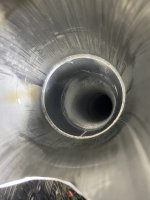Finished my new exhaust, 4" from front to rear. It is quite a tight fit, so I have added a lot of extra hangers to stop it moving around.
I have two flex joints, as the movement will be concentrated in the section between the engine block and the camper subframe. I have a semi rigid support from the back of the dump pipe, to the clutch cover, so that not all the load is taken on the turbo/exhaust brake flange.

I built it using V bands - will not use them again, as it makes it more difficult to line up when you take it on and off. When I make the 3" one 11 years ago, V-bands did not exist for normal use, and I thought they would be a good idea, and all the "experts" say they are the best thing to us. I suppose for a standard exhaust on a car, it might make it easier getting it on and off again. But because the rotate, it means that every time you put it back on, you have to rotate each section to the exact angle. With flanges, one you have them in place, putting the bolts in makes it automatically align.

A 4" exhaust is no doubt overkill for a 200hp motor, and I was worried it would be a bit noisy, so this time I added a straight through muffler to cut some of the noise out. Having this quite close to the transmission, I was worried about the radiant heat. I had the whole exhaust ceramic coated, to minimise the heat coming out, but also decided to make some heat shields to protect all the potentially sensitive areas, like the shift cylinder, air line connections etc.

This one is a Carbuilders Heat shield, which uses stand off brackets which are clamped to the muffler. it should protect the whole side of the transmission, with the range change cylinder, speedo sensor, etc.

The flex joints are also close to sensitive things like the hi-lo range cylinder, the centre diff lock/4WD connection. I made a heat shield out of a piece of embossed aluminium, if fits around the lower section of the second flex joint. It took a bit of fabrication, but it fits quite nicely. I put a 40mm hole in the bottom, to minimise any built up of dirt, but it will probably need regular cleaning out if we do a lot of driving in the mud. It is quite rigid, with the front and sides being doubled up to add strength.

I also extended the heat shield on the front, to protect the airlines and wiring that runs up the left hand side of the chassis.

It is a tight squeeze up through the chassis, coming close to the ALB, and over the chassis subframe. I will replace the foam heat shield along the battery box, that is looking a bit worse for wear after 10 years of service. using the embossed aluminium shielding. I gave up on the v-bands here, a this one need perfect alignment to miss everything.

There are seven different pieces to the exhaust, as it needs to be able to come out with back axle in place. To do this, I need to remove one of the air tanks, take the left hand fuel tank off, and the jerry can holder, and the rear wheel as well. I am hoping I never have to take it off again, and that's why I decided to spend the money to get the whole exhaust ceramic coated.
I decided on a polished stainless tailpipe, just because it looks nice.

Space is quite tight, but I think it will be enough with minimum of 25mm all around. The camper box is rigid, so it is just flex between the chassis and the sub frame that need to be catered for, and the rear section of the chassis doesn't move as much are the front section. There are four hanger on the rear section which restricts the movement, as the sub frame will not move, there is enough for any expansion and contraction, but it is a lot more rigidly connected than the old one.
I will be firing it up in the next few days, just need to put a few things back on before I start the engine up. Overall, I have only one 90 degree bend, with the rest being 45 degrees or less, and overall this new one has three less 90 degree bends than the old one. It should be a lot less restrictive, you can almost see the turbo from the tailpipe











 www.facebook.com
www.facebook.com

 www.facebook.com
www.facebook.com





















